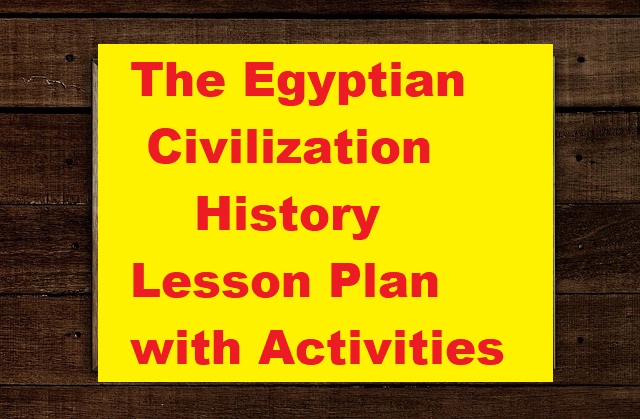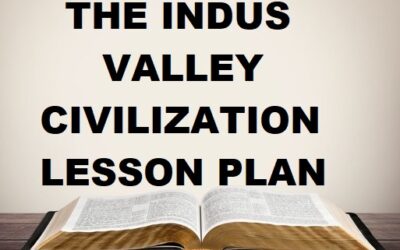The Egyptian Civilization: History Lesson Plan with Activities
The Egyptian Civilization is the greatest chapter in the history of humans with its splendorous culture, architectural marvels, and scientific progress. This Egyptian Civilization lesson plan allows teachers to introduce this amazing period of time in an educational and organized manner. Through definite objectives, activities, and graphics, it facilitates students to study how the Nile River influenced people’s lives and nourished the rise of a dominant civilization.
In addition, the Egyptian Civilization lesson plan inspires students to reflect critically upon the impact that ancient innovations have had on contemporary society. Through transition phrases like furthermore, therefore, and consequently, instructors are able to present students with a seamless transition from one idea to the next, guaranteeing logical comprehension.
This lesson plan matters because it not only enhances historical awareness but also fosters interest, analytical capacity, and human achievements appreciation. Finally, it makes classroom learning into an interactive excursion through ancient Egypt’s time-honored heritage.
History Class 6 ICSE Lesson Plan: Activity-Based Learning on River Valley Civilizations
The Egyptian Civilization: History Lesson Plan with Activities
Subject: History
Class: VI
Chapter: 2 – The Egyptian Civilization
Board: ICSE
Duration: 45–50 minutes
1. General Information
Teacher’s Name: __________________________
Subject: History
Topic: The Egyptian Civilization
Class: VI (ICSE)
Time Duration: 45–50 minutes
Teaching Method: Discussion, Explanation, Question–Answer, and Activity-Based Learning
Teaching Aids:
Textbook, World Map, Picture Charts (Pyramids, Nile River, Mummies, Pharaohs), Flashcards, Timeline Chart, Smart Board or PowerPoint Presentation (optional)
2. Learning Objectives
By the end of the lesson, students will be able to:
Identify the geographical location of Egypt and state the significance of the River Nile.
Describe the Egyptians’ social, political, and religious life.
Acknowledge the contributions of Egyptians in architecture, writing, and science.
Appreciate the role of Pharaohs in administration and religion.
Develop appreciation for ancient civilizations and their contribution to the modern world.
3. Introduction of the Topic (Engagement – 5 minutes)
Start the lesson by asking:
“Do you know anything about the pyramids or mummies? Where are they located?”
Display a photograph of the Pyramids of Giza or an outline map of ancient Egypt.
Inform pupils that Egypt is one of the earliest civilizations and flourished in the Nile River valley more than 5000 years ago.
Connect this to the subject:
???? “Now, we are going to learn about The Egyptian Civilization — its people, their way of life, and their tremendous achievements.”
4. Teaching Aids
Visual Aids:
Images or diagrams of pyramids, mummies, Pharaohs, and the Nile.
Maps:
Map illustrating Egypt’s location and the Nile River.
Audio-Visual Aids:
Brief video clip (optional) about life in Ancient Egypt.
Models/Props:
Model of pyramids or symbols of hieroglyphs.
Blackboard/Smartboard:
To record important points, dates, and vocabulary.
5. Lesson Procedure
Step 1: Explanation (15 minutes)
A. Where the Nile River is and Why It’s Important
Egypt is situated in North-Eastern Africa.
The River Nile was referred to as the “Gift of the Nile” because it gave them fertile land, water, and transportation.
B. Political Life
Pharaohs were important rulers who were thought to be gods on Earth.
Name famous Pharaohs such as King Menes, Tutankhamun, and Ramses II.
C. Social Life
Egyptian society was divided into classes: Pharaoh → Nobles → Priests → Scribes → Craftsmen → Farmers → Slaves.
Women had a high status and could possess property.
D. Religious Beliefs
Egyptians were polytheistic (they believed in multiple gods such as Ra – Sun God, Osiris – God of the Dead).
They had faith in life after death and they followed mummification to preserve the body.
E. Art and Architecture
Pyramids, temples, and tombs reflect their architectural prowess.
Hieroglyphic writing was invented; they wrote on papyrus.
F. Contributions
Egyptians developed medicine, mathematics, and calendars.
Step 2: Discussion (10 minutes)
Ask students:
“Why was the River Nile so vital for the Egyptians?”
“What did Pharaohs become powerful because of?”
“How do pyramids reflect the expertise of ancient Egyptians?”
Encourage interactive responses and address misconceptions.
6. Activity 1 (Group Work – 10 minutes)
Title: “Journey to the Land of the Pharaohs”
Split the class into 4–5 groups.
Each group researches (from charts or textbook) and presents one aspect of life in Egypt:
First Group: The Nile and Farming
Second Group: Pharaohs and State
Third Group: Gods and Religion
Fourth Group: Art and Building
Fifth Group: Writing and Understanding
All Groups show their mini-charts or give a brief talk on their topic.
7. Activity 2 (Individual Work – 10 minutes)
Title: “Decode the Hieroglyphs”
Give each student a worksheet containing some Egyptian hieroglyphic symbols.
Students attempt to decipher the provided message (for entertainment) or come up with their own names through hieroglyphic symbols.
Assists in strengthening creativity and knowledge of Egyptian writing.
8. Classwork
Short Answer Questions:
Why is Egypt referred to as the “Gift of the Nile”?
Who were Pharaohs? Give an example of one renowned Pharaoh.
What was mummification?
List two scientific or architectural contributions of the Egyptians.
Map Work: Mark and label:
River Nile
Pyramids of Giza
9. Homework
Sketch and label the social pyramid of ancient Egypt in your notebook.
Write 8–10 lines on “The Role of the River Nile in Egyptian Civilization.”
Study the important words: Pharaoh, Mummy, Hieroglyphics, Pyramids, Polytheism.
10. Learning Outcomes
By the end of the lesson, students will be able to:
- Locate Egypt and the Nile River on the map.
- Explain the lifestyle, religion, and rule of ancient Egyptians.
- Identify significant Egyptian contributions to art, architecture, and writing.
- Value how the Nile affected Egyptian civilization.
- Develop comparative insight between ancient and contemporary societies.
11. Remedial Measures
For pupils experiencing difficulty with the subject:
Repeat key points in simpler terms and through pictures.
Supply a summary sheet containing key facts and a social pyramid diagram.
Administer a brief recap quiz on key definitions (Pharaoh, Mummy, Nile, Pyramid).
Use narrative (“A Day in the Life of an Egyptian Farmer”) to assist with recall.
Match poorer students with better students for revising and mapping.
The Egyptian Civilization: History Lesson Plan with Activities
Conclusion:
The Egyptian Civilization remains captivating to students with its incredible achievement in art, architecture, and government. The Egyptian Civilization lesson plan is created to assist teachers in making the ancient world come alive with interactive teaching practices, interesting activities, and precise learning objectives. Using this organized plan, teachers can lead the students to realize how the Nile River influenced Egypt’s development and why the Egyptian Civilization emerged as one of history’s greatest. Additionally, the lesson plan cultivates critical thinking and curiosity, enabling the students to relate past innovations to current life. Using visual aids, discussions, and activity, it makes history an engaging tale of human achievement. The Egyptian Civilization lesson plan therefore provides teachers with an important resource to make history both engaging and relevant.
How was this lesson plan on The Egyptian Civilization useful in enhancing your teaching to be more effective and interactive?





0 Comments